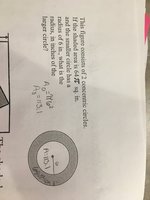I’m really unsure of how to do this problem and need some help. The image shows a large shaded circle with a smaller unshaded circle inside. It reads, "This figure consists of 2 concentric circles. If the shaded area is 64 (pi) sq. in. and the smaller circle has a radius of 6 in., what is the radius, in inches of the larger circle?" I wasn’t at school today and I have a little work done (as shown in the photo), but I’m really struggling and I have no clue what to do. Thanks for the help!! 
You are using an out of date browser. It may not display this or other websites correctly.
You should upgrade or use an alternative browser.
You should upgrade or use an alternative browser.
Geometry: shaded region formed by smaller circle being removed from larger circle; area is 64pi; smaller radius is 6
- Thread starter amp1053
- Start date
Dr.Peterson
Elite Member
- Joined
- Nov 12, 2017
- Messages
- 16,871
You've found that the inner circle has an area of [MATH]36\pi[/MATH] sq. in. What is the area of the outer circle (including shaded and unshaded parts)? What radius would give that area? (Note that it's better not to calculate decimal values for a problem like this, since they gave you the shaded area in terms of pi.)
Dr.Peterson
Elite Member
- Joined
- Nov 12, 2017
- Messages
- 16,871
Learning math is all about asking questions! (Sometimes you ask others, sometimes you ask yourself.)
First, don't forget the pi! You're adding [MATH]36\pi + 64\pi = 100\pi[/MATH], not just 100.
Suppose I gave you this problem:
You would, I hope, write an equation that expresses this fact, and try to solve it. What is the formula for the area of a circle?
First, don't forget the pi! You're adding [MATH]36\pi + 64\pi = 100\pi[/MATH], not just 100.
Suppose I gave you this problem:
If a circle's area is [MATH]100\pi[/MATH] sq. in., what is its radius?
You would, I hope, write an equation that expresses this fact, and try to solve it. What is the formula for the area of a circle?
Harry_the_cat
Elite Member
- Joined
- Mar 16, 2016
- Messages
- 3,779
Almost. \(\displaystyle 36\pi +64\pi = 100 \pi\) square inches.
Next step: Write down the formula for the area of a circle in terms of r. Let this equal \(\displaystyle 100\pi\) and solve for r.
Next step: Write down the formula for the area of a circle in terms of r. Let this equal \(\displaystyle 100\pi\) and solve for r.
Harry_the_cat
Elite Member
- Joined
- Mar 16, 2016
- Messages
- 3,779
Snap, Dr P.

